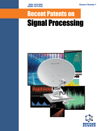- Home
- A-Z Publications
- Recent Patents on Signal Processing (Discontinued)
- Previous Issues
- Volume 4, Issue 1, 2014
Recent Patents on Signal Processing (Discontinued) - Volume 4, Issue 1, 2014
Volume 4, Issue 1, 2014
-
-
MAP Segmentation of Time-Frequency Rényi Entropy - Application in Seismic Signals Processing
More LessReliable seismic waves characterization is essential for better understanding wave propagation phenomena, providing new physical insight into soil properties. Many works in this area have been based on detecting special patterns or clusters in seismic data, event detection using parametric models, and time-frequency analysis. In this paper we present an approach making use of the short-term time-frequency Rényi entropy Read More
-
-
-
Cyclic Interleaving for Multiple Vertical Parities in Distributed Turbo Product Codes
More LessAuthors: Esam A. Obiedat and Lei CaoIn this paper, we design distributed Turbo Product Codes (TPC) for cooperative communications. Specifically, to improve performance by using multiple relays, we propose Cyclic Interleaver (CI), a novel method for TPC to obtain independent Multiple Vertical Parities (MVP) for different relays. With this method, codewords in different relays are all in the same coding space of the product codes and hence can be jointly decoded. Read More
-
-
-
An Efficient 2D and 3D Palmprint Identification System by Jointly Using Gabor Filter Response, Wavelet Transform and Radial Basis Function
More LessAuthors: Abdallah Meraoumia, Salim Chitroub and Ahmed BouridaneBiometric systems use automated methods for pattern recognition in determining the authenticity of a specific physiological or behavioral characteristic of an individual to determine or verify identity. In this work, 2D and 3D palmprints are integrated in order to construct an efficient multi-biometric identification system based on matching score level fusion. In this paper, we try to evaluate the usefulness of the 2D and Read More
-
-
-
Video Intra Coding for Compression and Error Resilience: A Review
More LessAuthors: Martin Fleury, Ismail A. Ali and Mohammed GhanbariIntra-coding is the application of spatial prediction coding to video data either on a whole frame basis or on individual macroblocks. This paper outlines the growing sophistication in intra-coding within recent standard codecs, the topic which is primarily relevant to compression for data storage. It then specializes to intra-coding for error resilience and intra-refresh, the topic which is relevant to video streaming applicatio Read More
-
-
-
Vibration Based Fault Diagnosis Study of an Automobile Brake System Using K Star (K*) Algorithm – A Statistical Approach
More LessAuthors: R. Jegadeeshwaran and V. SugumaranIn automobiles, the brake system is an essential part responsible for control of the vehicle. Any failure in the brake system generates subsequent catastrophic effects on the vehicle cum passenger’s safety. Hence condition monitoring of the brake system is indispensable. This study focuses on the condition monitoring of a hydraulic brake system through vibration analysis. A machine learning approach was used for this vibratio Read More
-
Volumes & issues
Most Read This Month
Article
content/journals/rptsp
Journal
10
5
false
en


